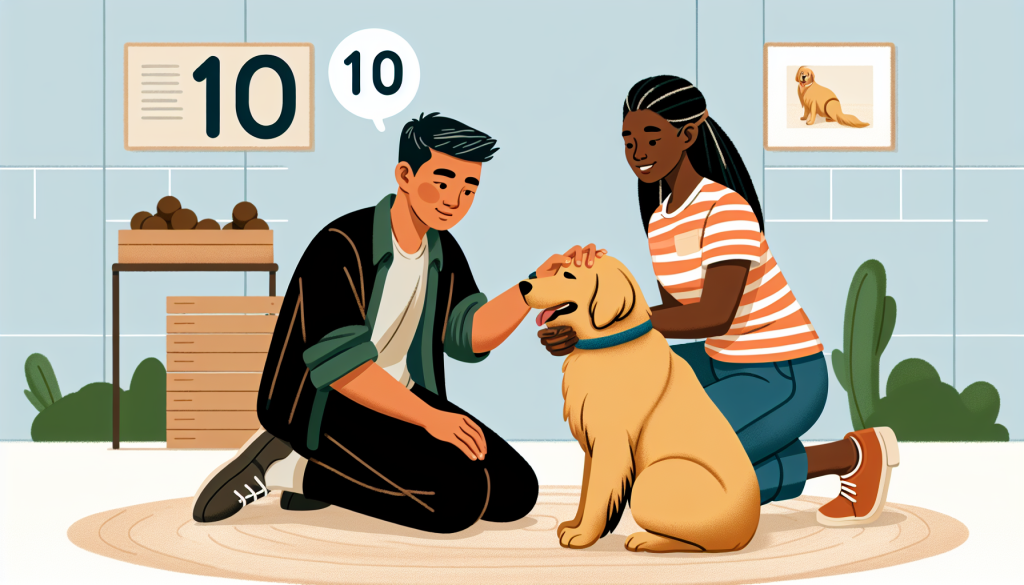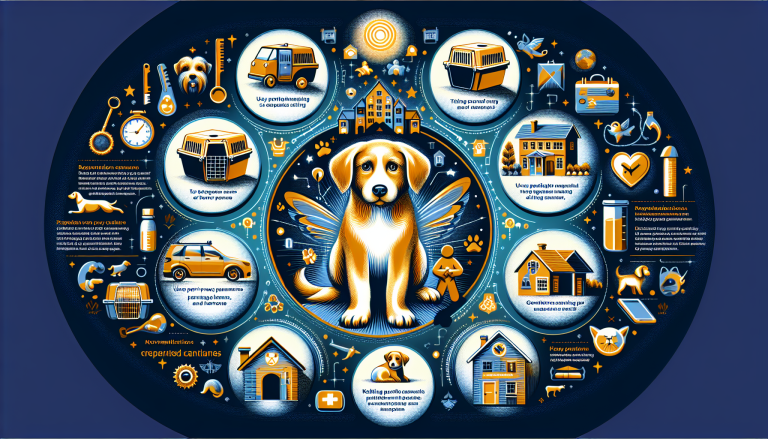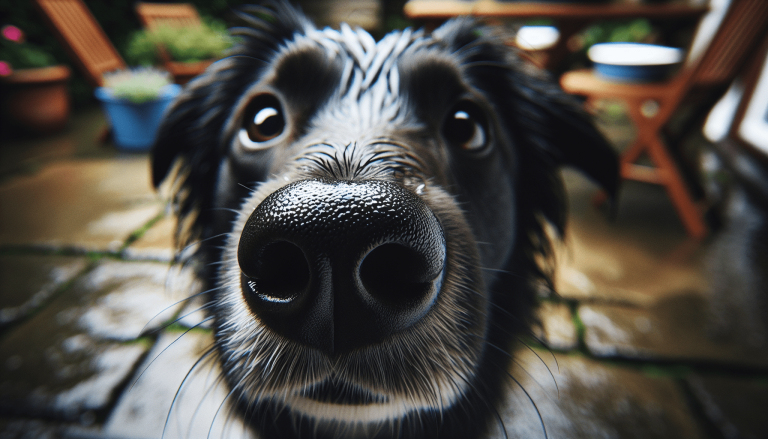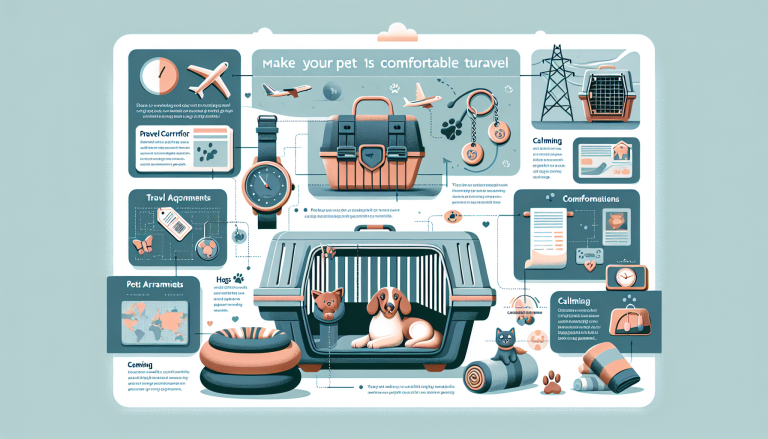Is your furry friend a bit shy and timid around new faces? Don’t worry, we’ve got you covered! In this article, you’ll find ten helpful tips to help ease your pet’s anxiety and make introductions to new people a breeze. From building trust and providing a safe space to using positive reinforcement techniques, these tips will ensure that your pet feels comfortable and confident in any social setting. Say goodbye to nervousness and hello to a happy, sociable pet!
Table of Contents
TogglePreparing your pet for introductions
Introducing your pet to new people can be an exciting and rewarding experience for both you and your furry friend. However, it’s important to prepare your pet beforehand to ensure a smooth and positive introduction. By understanding your pet’s temperament, training them to be calm and obedient, socializing them from an early age, and creating a safe and comfortable space, you can set the foundation for successful introductions.
Understanding your pet’s temperament
Every pet has a unique temperament, which plays a significant role in how they interact with others. Take the time to observe and understand your pet’s temperament. Are they generally outgoing and friendly, or are they more reserved and cautious? By understanding your pet’s temperament, you can tailor your approach to introductions and make accommodations if needed.
Training your pet to be calm and obedient
Basic obedience training is essential for any pet, especially when it comes to introductions. Teaching your pet to stay calm and follow commands can help them navigate social interactions with ease. Practice commands such as sit, stay, and come, reinforcing them with treats and positive reinforcements. This will not only improve your pet’s behavior but also give them the confidence to handle new situations.
Socializing your pet from an early age
Socialization is key to ensuring your pet is comfortable around new people. Start socializing your pet from a young age by exposing them to various environments, sounds, and experiences. Gradually introduce them to different people, including children, the elderly, and strangers. This exposure will help them become well-rounded and adapt to different social situations.
Creating a safe and comfortable space
Before introducing your pet to new people, it’s important to create a safe and comfortable space for them. Make sure your pet has a designated area where they can retreat to if they feel overwhelmed. Provide them with their favorite toys, blankets, and treats to help them feel secure. This safe space will act as a sanctuary for your pet during introductions and help alleviate any anxiety or stress they may experience.
Setting expectations for your pet’s behavior
When introducing your pet to new people, it’s essential to set clear expectations for their behavior. This includes teaching them basic commands and manners, establishing boundaries and rules, recognizing signs of fear or aggression, and implementing positive reinforcement techniques.
Teaching basic commands and manners
Before introducing your pet to new people, make sure they have a solid foundation of basic commands and manners. Commands such as sit, stay, and leave it can help you redirect your pet’s attention and maintain control in various situations. Additionally, teaching your pet to greet people politely without jumping or excessive barking will make introductions much smoother.
Establishing boundaries and rules
Establishing boundaries and rules for your pet is crucial when it comes to introductions. Decide where your pet is allowed to be during social interactions and communicate these boundaries to both your pet and the people you are introducing them to. Make it clear that unwanted behaviors such as jumping or excessive licking are not acceptable.
Recognizing signs of fear or aggression
It’s essential to be able to recognize signs of fear or aggression in your pet during introductions. These signs may include growling, barking, raised fur, or a stiff body posture. If you notice any of these signs, it’s important to intervene and remove your pet from the situation to prevent any potential conflicts. Understanding your pet’s body language will help you assess their comfort level in new situations.
Implementing positive reinforcement techniques
Positive reinforcement is a highly effective training method when it comes to introducing your pet to new people. Use treats, praise, and rewards to reinforce positive behavior and create positive associations with social interactions. This will not only make introductions more enjoyable for your pet but also encourage them to display good behavior in the future.
Introducing your pet to new people
Introducing your pet to new people can be a gradual process that requires patience and careful planning. By choosing the right time and place, allowing your pet to approach at their own pace, using treats and positive reinforcement, creating a calm and relaxed environment, and providing proper leash and/or crate etiquette, you can ensure a successful introduction.
Choose the right time and place
When introducing your pet to new people, it’s important to choose a time and place that is calm and free from distractions. Avoid introducing your pet when they are hungry, tired, or in an overly stimulating environment. You want to create an ideal setting where your pet can focus and feel comfortable.
Allow your pet to approach at their own pace
Every pet has their own comfort zone, and it’s essential to respect their boundaries. Allow your pet to approach new people at their own pace. If they seem hesitant or nervous, give them the space they need and avoid forcing interactions. Patience is key in allowing your pet to build trust and confidence in social situations.
Use treats and positive reinforcement
Treats are a powerful tool when it comes to introducing your pet to new people. Use treats to reward your pet for calm and friendly behavior during introductions. This positive reinforcement will help your pet associate new people with positive experiences and increase their willingness to engage in social interactions.
Create a calm and relaxed environment
Creating a calm and relaxed environment is essential for successful introductions. Avoid loud noises, crowded spaces, or chaotic situations that could overwhelm your pet. Choose a quiet area where your pet can feel at ease and focus on the introduction. Keep the energy level low and encourage everyone involved to speak softly and move calmly.
Provide proper leash and/or crate etiquette
If your pet is particularly anxious or needs more control during introductions, using a leash or crate can be helpful. A leash provides you with the ability to guide your pet and redirect their attention if needed. A crate can serve as a safe and secure space for your pet to observe and acclimate to new people from a distance. Use these tools responsibly to ensure both your pet’s safety and the comfort of the people they are being introduced to.
Dealing with specific situations
Introducing your pet to different types of people requires some specific considerations and approaches. Whether it’s introducing your pet to children, elderly individuals, other pets, strangers, or people with allergies, there are strategies that can help ensure a positive experience for everyone involved.
Introducing your pet to children
When introducing your pet to children, it’s crucial to prioritize safety and supervision. Teach children how to approach and interact with pets gently, avoiding sudden movements or loud noises. Encourage them to let the pet approach them rather than actively pursuing the pet. Supervise all interactions between children and pets to ensure the well-being of both parties.
Introducing your pet to elderly individuals
Just like with children, introducing your pet to elderly individuals requires a gentle and patient approach. Elderly individuals may have limited mobility or sensory impairments, so it’s important to educate them on how to interact with your pet safely. Encourage them to move slowly and calmly when approaching or petting the animal. Supervise these interactions to avoid any accidental falls or injuries.
Introducing your pet to other pets
Introducing your pet to other pets should be done gradually and under controlled circumstances. Start with a neutral territory, such as a park or a space not claimed by either pet. Keep both pets on leashes initially to maintain control and prevent any sudden aggressive behavior. Allow them to sniff and observe each other from a distance, gradually decreasing the distance as they become more comfortable. Be prepared to intervene and separate the pets if necessary.
Introducing your pet to strangers
Introducing your pet to strangers can be challenging, as every pet reacts differently to new faces. Start by allowing your pet to observe the stranger from a distance. If your pet remains calm, you can gradually decrease the distance and encourage a gentle interaction. However, always prioritize your pet’s comfort and be prepared to redirect or remove them from the situation if they become anxious or fearful.
Introducing your pet to people with allergies
If you have a pet and you are introducing them to someone with allergies, it’s important to be considerate and inform the allergic individual about the situation beforehand. Ensure that they are comfortable with being around animals and take necessary precautions to minimize exposure, such as using allergen-reducing sprays or keeping the pet in a separate area during the visit.
Handling your pet’s anxiety or fear
Not all pets are naturally comfortable in social situations, and some may experience anxiety or fear when introduced to new people. By identifying signs of anxiety or fear, gradually exposing your pet to new people, using calming techniques and products, and seeking professional help if necessary, you can help your pet overcome their fears and become more confident.
Identifying signs of anxiety or fear
It’s important to be able to recognize signs of anxiety or fear in your pet. These signs may include panting, trembling, tucked tail, excessive drooling, hiding, or attempting to escape. If you notice any of these signs, it’s crucial to address your pet’s anxiety or fear and take steps to alleviate their discomfort.
Gradually exposing your pet to new people
Gradual exposure is key when it comes to helping your pet overcome their anxiety or fear of new people. Start with short and controlled interactions with individuals your pet is familiar with and gradually introduce new people. This slow progression will give your pet the opportunity to adjust to new faces while feeling safe and secure.
Using calming techniques and products
There are various calming techniques and products that can help reduce your pet’s anxiety or fear. These may include playing soothing music, using pheromone diffusers, practicing relaxation exercises, or utilizing anxiety wraps or vests. Experiment with different techniques and find what works best for your pet’s unique needs.
Seeking professional help if necessary
If your pet’s anxiety or fear persists despite your best efforts, it may be beneficial to seek professional help from a veterinarian or animal behaviorist. These experts can assess your pet’s specific situation and provide tailored advice and guidance to help your pet overcome their fears.
Ensuring a successful introduction
To ensure successful introductions, there are several key factors to keep in mind. These include supervising the interaction, keeping the environment stress-free, encouraging positive interactions, and rewarding your pet’s good behavior.
Supervising the interaction
Always supervise any interaction between your pet and a new person. This ensures the safety of both parties and allows you to intervene if any issues arise. Pay close attention to your pet’s behavior and the reactions of the person being introduced. If either party becomes uncomfortable or tense, take a step back and reassess the situation.
Keeping the environment stress-free
Creating a stress-free environment is crucial for a successful introduction. Eliminate any potential stressors, such as loud noises or crowded spaces, that could make your pet feel anxious or overwhelmed. Control the environment as much as possible to maintain a calm and relaxed atmosphere.
Encouraging positive interactions
During introductions, it’s important to encourage positive interactions between your pet and the new person. Reward your pet for calm and friendly behavior, and provide praise and treats when they exhibit appropriate social manners. This positive reinforcement will reinforce good behavior and help your pet associate new people with positive experiences.
Rewarding your pet’s good behavior
Throughout the introduction process, be sure to consistently reward your pet’s good behavior. This can be done with treats, verbal praise, or their favorite toy. By providing positive reinforcement, you are reinforcing the desired behavior and setting the stage for future successful introductions.
Recognizing warning signs
While introductions should ideally be positive experiences, it’s important to be able to recognize warning signs that indicate potential issues. By being aware of signs of aggression, discomfort or stress, and understanding your pet’s body language cues, you can identify when to intervene and prevent any conflicts.
Signs of aggression
Signs of aggression in pets may include growling, baring teeth, lunging, or snapping. If you observe any of these signs, it’s important to intervene immediately to prevent any potential harm to both people and other animals. Seek professional help if necessary to address and manage aggression issues in your pet.
Signs of discomfort or stress
Pets may exhibit signs of discomfort or stress during introductions, such as excessive panting, licking lips, raised hackles, or trying to escape. If you notice these signs, it’s important to gauge your pet’s level of comfort and evaluate whether they need more time or a different approach. Adjust the introduction process accordingly to alleviate their stress.
Body language cues to watch for
Your pet’s body language can provide valuable insight into their comfort level during introductions. Pay attention to cues such as a relaxed body posture, wagging tail, loose facial muscles, and soft eyes, which indicate that your pet is comfortable and at ease. Conversely, stiff body posture, raised fur or feathers, and a high tail carriage can indicate fear or discomfort.
Knowing when to intervene
Knowing when to intervene is crucial to prevent any potential issues during introductions. If you observe warning signs of aggression, extreme fear, or discomfort in either your pet or the person being introduced, it’s important to step in and remove your pet from the situation. Your priority should always be the safety and well-being of everyone involved.
Addressing common challenges
Introducing your pet to new people can sometimes present challenges that require specific strategies. Some common challenges include dealing with overexcitement and jumping, excessive barking or growling, resource guarding behavior, and nervousness or shyness. By addressing these challenges head-on, you can help your pet overcome them and have successful interactions.
Overexcitement and jumping
If your pet gets overly excited and tends to jump on people during introductions, it’s important to redirect their behavior. Teach them an alternative behavior, such as sitting or offering a paw, that they can perform instead of jumping. Reward and reinforce this alternate behavior consistently to effectively address the overexcitement.
Excessive barking or growling
Excessive barking or growling when meeting new people can be a sign of fear, anxiety, or territorial behavior. It’s important to address the underlying issue causing the vocalization. Practice desensitization exercises with your pet to gradually reduce their reactivity to new people. Seek professional help if these behaviors persist or escalate.
Resource guarding behavior
If your pet displays resource guarding behavior, such as growling or becoming territorial over toys, food, or personal space, it’s important to address this issue before introducing them to new people. Consult with a professional trainer or behaviorist who can provide guidance on managing and modifying this behavior effectively.
Nervousness or shyness
Some pets may naturally be more nervous or shy when meeting new people. It’s important to respect their comfort levels and gradually build their confidence. Provide positive reinforcement and plenty of praise when they display calm and relaxed behavior during introductions. Over time, they may become more comfortable and less nervous around new people.
Educating others about your pet
When introducing your pet to new people, it’s essential to educate them about your pet’s needs. This includes informing guests about your pet’s needs, teaching proper handling techniques, providing information on allergies or fears, and refusing interactions when necessary.
Informing guests about your pet’s needs
Make sure to inform guests about your pet’s specific needs, such as any fears or sensitivities they may have. Let guests know how to approach and interact with your pet to ensure a positive experience for everyone involved. This open communication will help create a safe and comfortable environment for your pet and minimize any potential misunderstandings.
Teaching proper handling techniques
Not everyone may be familiar with how to handle or interact with pets. Take the time to teach proper handling techniques to those interacting with your pet. Teach them to approach slowly, avoid sudden movements or loud noises, and let the pet sniff and initiate contact if comfortable. Ensuring that people interact respectfully and appropriately will help your pet feel secure during introductions.
Providing information on allergies or fears
If your pet has specific allergies or fears, it’s important to inform people in advance. Let them know if your pet has any food allergies or environmental sensitivities. Additionally, inform guests if your pet has any fears or anxieties, such as a fear of thunderstorms or loud noises. By providing this information, you can ensure that those interacting with your pet can adjust their behavior accordingly.
Refusing interactions when necessary
As a responsible pet owner, it’s essential to prioritize your pet’s well-being and safety. If your pet shows signs of discomfort or stress during an introduction, it’s okay to refuse interactions. Politely communicate to others that your pet needs some space or time to adjust. Advocating for your pet’s needs is crucial in ensuring their overall well-being.
Monitoring progress and adjustment
Introducing your pet to new people is a process that requires ongoing monitoring and adjustment. By noticing improvements over time, identifying areas that need more work, adapting strategies as your pet grows, and celebrating milestones and achievements, you can continue to facilitate positive introductions.
Noticing improvements over time
Throughout the introduction process, pay attention to any improvements you notice in your pet’s behavior. This may include increased confidence, reduced anxiety, or improved social skills. Recognizing these improvements will boost your pet’s morale and encourage positive progress.
Identifying areas that need more work
While celebrating improvements, it’s also important to identify areas that may still need more work. If your pet continues to display anxiety or fear during certain types of introductions, focusing on those specific areas can help them overcome their limitations. Implement targeted training and socialization exercises to address these challenges.
Adapting strategies as your pet grows
Just like humans, pets grow and change over time. What may have worked during initial introductions may not be as effective as your pet matures. Be open to adapting your strategies and techniques as your pet grows and progresses. This flexibility will ensure that you are continually meeting their needs and facilitating positive experiences.
Celebrating milestones and achievements
Introducing your pet to new people can be a journey filled with milestones and achievements. Take the time to celebrate these moments, no matter how small they may seem. Whether it’s your pet confidently greeting a new person or displaying calm behavior throughout an interaction, acknowledge and reward their progress. Celebrating milestones will strengthen the bond between you and your pet and motivate them to continue making strides in their social development.
In conclusion, introducing your pet to new people can be an enriching and enjoyable experience when approached with the right techniques and mindset. By understanding your pet’s temperament, training them to be calm and obedient, providing proper socialization, and creating a safe space, you can lay the foundation for successful introductions. Setting expectations for your pet’s behavior, choosing the right time and place, using treats and positive reinforcement, and ensuring a calm environment will contribute to a positive introduction. Handling specific situations, addressing common challenges, monitoring your pet’s anxiety or fear, and educating others about your pet will facilitate smooth introductions. Lastly, by recognizing warning signs, supervising interactions, and celebrating milestones, you can ensure the well-being of your pet and create positive social experiences for both them and the people they meet.








